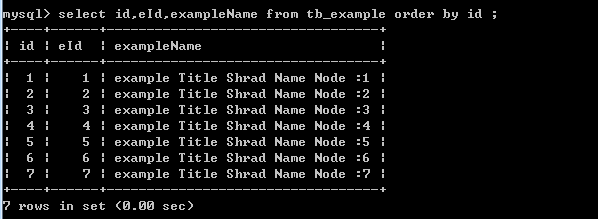spring-mybatis-data-common-2.0新增分表机制,在1.0基础上做了部分调整.
基于机架展示分库应用
数据库分表实力创建
create table tb_example_1(
id bigint primary key auto_increment ,
eId bigint,
exampleName varchar(40),
exampleTitle varchar(200),
exampleDate datetime
)ENGINE=MyISAM DEFAULT CHARSET=utf8 AUTO_INCREMENT=1 ;
create table tb_example_2 like tb_example_1;
create table tb_example_3 like tb_example_1;
create table tb_example(
id bigint primary key auto_increment ,
eId bigint,
exampleName varchar(40),
exampleTitle varchar(200),
exampleDate datetime
)ENGINE=MERGE UNION=(tb_example_1,tb_example_2,tb_example_3) INSERT_METHOD=LAST AUTO_INCREMENT=1 ;
程序构建分表操作
1.spring-mybatis-common-data中提供了com.spring.mybatis.data.common.model.ExampleModel用于Demo的实体类
添加maven依赖
<project xmlns="http://maven.apache.org/POM/4.0.0" xmlns:xsi="http://www.w3.org/2001/XMLSchema-instance" xsi:schemaLocation="http://maven.apache.org/POM/4.0.0 http://maven.apache.org/maven-v4_0_0.xsd"> <modelVersion>4.0.0</modelVersion> <groupId>com.spring.mybatis</groupId> <artifactId>com-spring-mybatis-common-data-demo</artifactId> <packaging>war</packaging> <version>0.0.1-SNAPSHOT</version> <name>com-spring-mybatis-common-data-demo Maven Webapp</name> <url>http://maven.apache.org</url> <properties> <project.build.sourceEncoding>UTF-8</project.build.sourceEncoding> <spring.mybatis.data.version>2.0</spring.mybatis.data.version> <junit.version>4.11</junit.version> </properties> <dependencies> <!-- spring-mybatis-data-common begin --> <dependency> <groupId>com.spring.mybatis</groupId> <artifactId>spring-mybatis-data-common</artifactId> <version>${spring.mybatis.data.version}</version> </dependency> <!-- spring-mybatis-data-common end --> <dependency> <groupId>junit</groupId> <artifactId>junit</artifactId> <version>${junit.version}</version> <scope>test</scope> </dependency> <dependency> <groupId>com.alibaba</groupId> <artifactId>druid</artifactId> <version>0.2.26</version> </dependency> <dependency> <groupId>mysql</groupId> <artifactId>mysql-connector-java</artifactId> <version>5.1.1</version> </dependency> <dependency> <groupId>org.codehaus.jackson</groupId> <artifactId>jackson-mapper-asl</artifactId> <version>1.9.13</version> </dependency> </dependencies> <build> <finalName>com-spring-mybatis-common-data-demo</finalName> </build> </project>
2.持久层继承分表Dao接口,也可以自己定义
@Repository
public interface ExampleModelDao extends ShardCudDao<ExampleModel>,ShardReadDao<ExampleModel>{
/**get common base table max auto_increment id*/
public Long selectMaxId() throws DaoException;
}
在持久层自定义了一个selectMaxId()用于多个分表共享同一个自增策略,这里采用程序级别控制
3.业务层继承分表,业务层操作可以自定义,也可以继承com.spring.mybatis.data.common.service.BaseService中提供的常规业务
@Service
public class ExampleModelService extends BaseShard{
@Autowired
private ExampleModelDao exampleModelDao;
@Override
public String getBaseShardTableName() {
return "tb_example_";
}
@Override
public int getShardTableCount() {
return 3;
}
public int deleteObject(ExampleModel entity) throws ServiceException {
try {
return this.exampleModelDao.delete(getShardTableName(entity.geteId()+"", 1), entity.getId());
} catch (DaoException e) {
e.printStackTrace();
}
return 0;
}
public int save(ExampleModel entity) throws ServiceException {
long mxId = 1;
try {
Long maxId = this.exampleModelDao.selectMaxId();
if(null != maxId && maxId >= 1){
mxId = maxId + 1;
}
} catch (DaoException e) {
LogUtils.dao.error("insert exampleModel before get Max Id error.",e);
e.printStackTrace();
}
try {
entity.setId(mxId);
return this.exampleModelDao.insert(getShardTableName(entity.geteId()+"", 1), entity);
} catch (DaoException e) {
LogUtils.dao.error("insert exampleModel to table " + getShardTableName(entity.geteId()+"", 1) + " error");
e.printStackTrace();
}
return 0;
}
public ExampleModel selectObject(ExampleModel entity)
throws ServiceException {
try {
return this.exampleModelDao.selectById(getShardTableName(entity.geteId()+"", 1), entity.geteId());
} catch (DaoException e) {
e.printStackTrace();
}
return null;
}
public void setExampleModelDao(ExampleModelDao exampleModelDao) {
this.exampleModelDao = exampleModelDao;
}
}
BaseShard是一个抽象类,继承它需要实现两个方法.
/**
* get shard table count
* @return
*/
public abstract int getShardTableCount();
/**
* get base shard name
* @return
*/
public abstract String getBaseShardTableName();
getShardTableCount()用于返回分表数量, public abstract String getBaseShardTableName()用于返回分表表名统一前缀.
如实例中的分表为tb_example、tb_example_1、tb_example_2、tb_example_3,分表表名前缀为"tb_example_",分表数量为3.
BaseShard中获取映射表名的操作
/**
* get shard table name <br>
*
* shard table index start with 0
*
* just like follows
*
* tb_example_0
* tb_example_1
* tb_example_2
* tb_example_3
*
* @param tableName
* @return
*/
public String getShardTableName(String shardKey);
/**
* get shard table name <br>
*
* shard table index start with (0+baseNumber)
*
* just like follows
*
* tb_example_(0+baseNumber)
* tb_example_(1+baseNumber)
* tb_example_(2+baseNumber)
* tb_example_(3+baseNumber)
*
*
* @param shardKey
* @param baseNumber
* @return
*/
public String getShardTableName(String shardKey,int baseNumber);
4.持久层实现
<?xml version="1.0" encoding="UTF-8"?> <!DOCTYPE mapper PUBLIC "-//mybatis.org//DTD Mapper 3.0//EN" "http://mybatis.org/dtd/mybatis-3-mapper.dtd"> <mapper namespace="com.spring.mybatis.common.data.demo.dao"> <!--insert entity--> <insert id="insert" parameterType="exampleModel" flushCache="true"> INSERT INTO ${tablename}( id, eId, exampleName, exampleTitle, exampleDate) VALUES( #{object.id}, #{object.eId}, #{object.exampleName}, #{object.exampleTitle}, #{object.exampleDate} ) </insert> <select id="selectMaxId" resultType="long"> select max(id) from tb_example </select> <delete id="delete" parameterType="long" flushCache="true"> DELETE FROM ${tablename} WHERE id=#{id} </delete> <select id="selectById" parameterType="long" resultType="exampleModel"> SELECT id AS id,eId AS eId,exampleName AS exampleName,exampleTitle AS exampleTitle,exampleDate AS exampleDate FROM ${tablename} WHERE id=#{id} </select> </mapper>
程序运行结果

查询各个分表
实例下载: http://files.cnblogs.com/dennisit/spring-mybatis-data-common-2.0-and-demo.7z